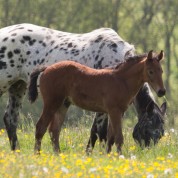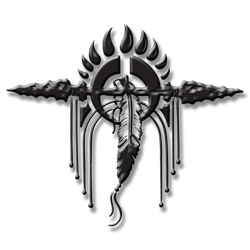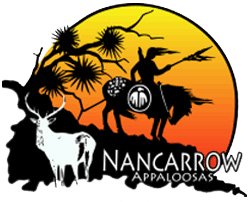
Here is a brief history of how the Appaloosa breed came about.
The introduction of the spotted horses to the West Coast of America from Europe and it’s introduction to the Native American Peoples that lived there.

How the breed, like the Native American people, were all but wiped out by the western settlers only to re-emerge years later to become the distinct and prized breed that it is today.
The History of the Appaloosa
No-one can be certain of the true origins of today’s Appaloosa breed. The earliest records of spotted horses are dated at around 18,000 BC and can be found in the cave paintings at Lascaux and Peche-Merle in France. It is not known for sure but these images could represent the earliest ancestors of today’s Appaloosas.
Spotted horses are also mentioned throughout the histories of the continents of Europe and Asia in countries such as Austria, France, Denmark and China.
There are many theories as to how today’s Appaloosa breed came to be. It is almost certain that a line was introduced by the Spanish Conquistadors whom are known to have taken vividly marked horses to America with them.
The Spanish are also known to have introduced the spotted horses to the West Coast of America through trade with Spanish settlers and the Native American peoples. It is also known that these horses went “out of fashion” in Europe during the late 18th Century which would also have contributed to the influx of the spotted horse as they would have been imported from Europe.

Our favourite “theory” comes directly from the story of the “Ghost Wind Stallions” handed down through the oral tradition of storytelling. It is the story of three stallions that came from the sea to the land of the Nez Perce.
“It happened hundreds of years ago, before our country (modern day America) was born.
A ship from a faraway land (we now know as Russia) came to the shores of the Pacific Northwest. The stallions were sent from the ship to swim to Nez Perce traders, who received these amazing creatures with awe. Tradition tells of their silvery white bodies, of black marks on their faces and legs, and speckles on their muzzles.
These stallions had powerful medicine. When they were bred with the tribe’s mares, this medicine was passed down to their young.”
Known as the “Ghost Wind Stallions”, these three horses are believed by some to be the ancestors of the Appaloosas, whose history mingles closely with that of the Nez Perce.
The Appaloosa horses became an integral part of the lives of the Nez Perce Indians. Used in competition they could out run the other breeds in short sprints and longer endurance races. When hunting they could out run the buffalo they hunted. As warriors it was believed that the appaloosas were trained to knock an enemy rider from his horse and then attack the enemy warrior with it’s hooves and tear at them with their teeth.
Despite these varied theories of the evolution of the Appaloosa breed, the fact still remains undisputed: Wherever the Nez Perce Appaloosas came from they had and still have a speed, an endurance, a disposition, and a colouration that set them apart from all other horses.
Unfortunately, as was the plight of the majority of the Native American peoples, pressure was brought to bear by the western settlers for these skilled horse breeders to give up their lands piece by piece. Through broken treaty after broken treaty, it was this action that lead to the Nez Perce War of 1877.
The entire tribe of Nez Pearce Indians, men, women, children and all of its horses embarked on a journey that would take three months to cover the 1,300 miles that would take them towards Canada and hopefully refuge. Many people and horses were lost along the way, not only to the harshness of the terrain they travelled but also to the bullets of the pursuing soldiers.

Only a few miles from the Canadian border the Nez Perce found themselves besieged and outnumbered by the US cavalry. Chief Joseph was left with no option but to surrender and he and his now captured people were forced to settle far away from their homelands and without their treasured horses. Chief Joseph knew he and his people would never see their lands again.
The fate of the surviving horses that did not manage to escape into the hills was sale by US Cavalry whilst the remainder were slaughtered, leaving the American breed of Appaloosas on the brink of extinction.
In 1937 an American publication “Western Horseman” published an article which rekindled an interest in the Appaloosa breed and by 1938 an organisation was founded that would help resurrect and preserve the breed in America. This organisation known as the “Appaloosa Horse Club of America”.

